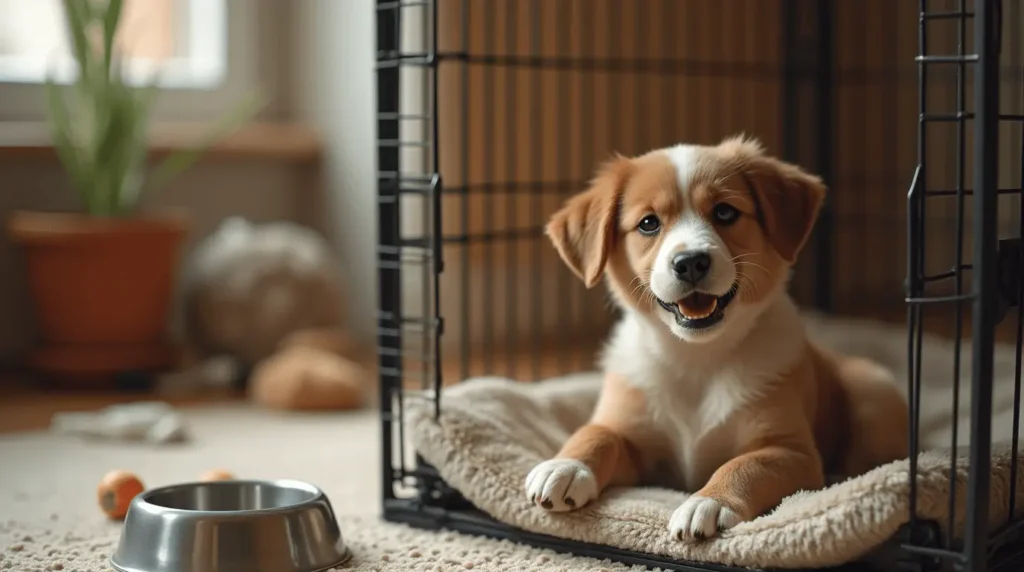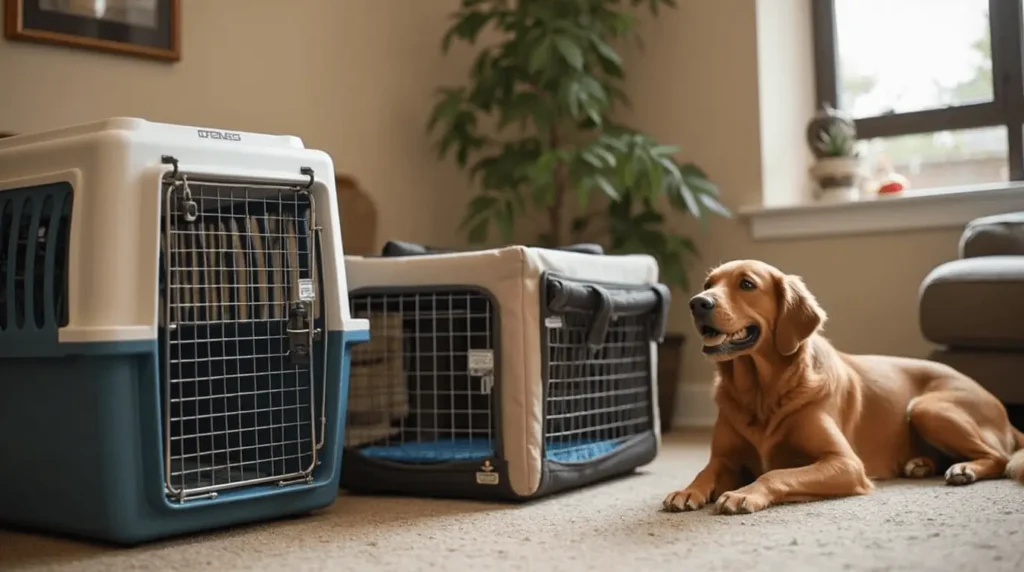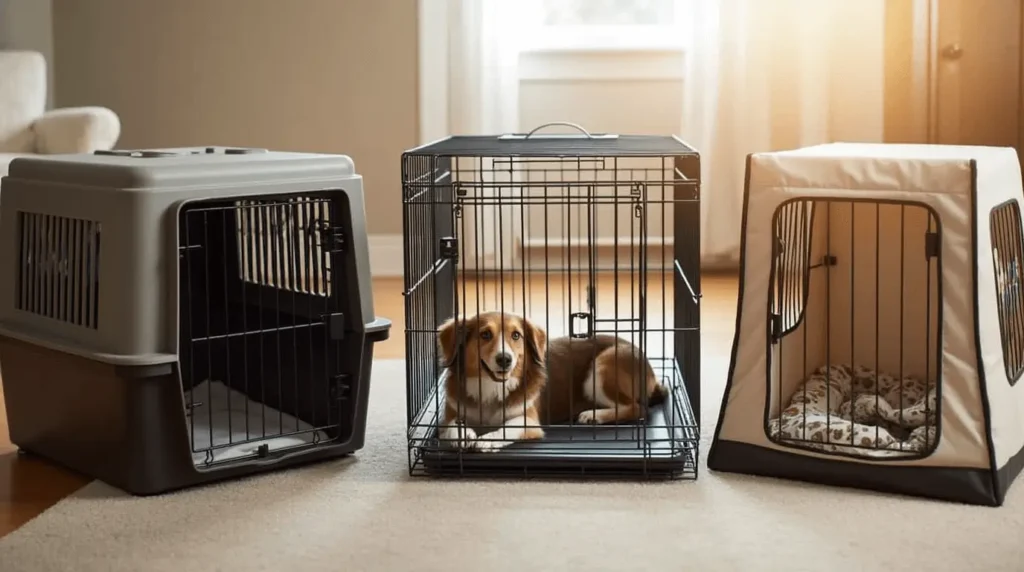How to Crate Train a Dog: A Step-by-Step Guide for Beginners
Crate training is a great way to provide a safe, cozy spot for your puppy or adult dog. If you’re wondering how to crate train a dog effectively, this guide will walk you through the entire process.
I’ll show you how to make a crate a safe haven for your pet. This guide works for puppies and adult dogs alike and offers practical tips for a positive crate training experience.
Crate training taps into a dog’s instinct for a quiet, safe spot. The right approach can make your dog love their crate. It also helps with house training and reduces anxiety.
My methods will help you overcome crate training challenges. Your dog will feel safe, secure, and happy in their space. I’ll cover everything from choosing the right crate to gradual training.
Follow this guide to crate train your dog well. You’ll create a positive space that supports their growth. Let’s start this training journey together!

How to Crate Train a Dog: The Benefits You Need to Know
Make crate training easy and stress-free! 🐶 Learn the best tips and techniques here.
In this section, we will explore the many advantages of crate training your dog. Crate training is not just about providing a secure space, but it can also help with housebreaking, separation anxiety, and more.
Natural Den Instincts in Dogs
Dogs have a natural need for safe, enclosed spaces. A crate meets this need, acting like a *personal sanctuary*. It’s like the dens their wild ancestors used. Most vets agree dogs like small, safe spots to feel secure.
Security and Comfort Benefits
A crate is a safe spot for dogs when they’re feeling scared or stressed. It’s a steady, calm place during loud storms or fireworks. Crate training makes dogs more emotionally strong.
Behavioral Advantages of Crate Training
Using a crate stops dogs from getting into trouble. It helps with potty training since dogs don’t want to mess their bed. It also helps with separation anxiety, making dogs feel safe and happy at home.

Choosing the Best Crate for Crate Training Your Dog
Choosing the right crate for your dog is essential to successful crate training. Learn about the different types of crates and how to pick the one that best suits your dog’s needs.
There are many crate types to choose from. Plastic crates are tough and good for flying. Metal wire crates are well-ventilated and easy to fold. Soft-sided crates are light and perfect for small dogs who don’t chew much.
Choosing the right size is crucial. The crate should let your dog stand, turn, and lie down easily. Pro tip: Measure your dog and add 3-4 inches to both height and length to ensure the perfect fit. For puppies, an expandable crate is a smart choice as it grows with your dog, saving money.
When crate training, look for features that add comfort and function. Removable dividers are great for puppies, allowing you to adjust the crate’s size as they grow. Make sure the crate has good ventilation and a washable, cozy bed or mat.
Every dog is different, so what works for one might not work for another. Take time to see what your dog likes and choose a crate that makes them feel safe and secure.
Step-by-Step Instructions on How to Crate Train a Dog
Follow these simple steps on how to crate train a dog effectively. We will guide you through the process, from introducing the crate to creating positive associations.
Choosing the right spot for your dog crate is important. Look for a quiet, easy-to-get-to place, away from sun and drafts. It should feel like a cozy den where your dog can relax and feel safe.
Comfort Items and Accessories
A well-equipped crate is essential for crate training. Get a soft, supportive bed that fits well inside the crate. Pick materials that are easy to clean and comfy. Add favorite toys to make it inviting – like Kongs to help with anxiety.
Safety Considerations
When using a crate, safety comes first. Make sure the crate is the right size. Your dog should be able to stand, turn, and lie down easily. Use zip ties to keep the edges secure. The crate size varies, from 24-30 inches for small to medium breeds, and 36-48 inches for larger dogs.
A well-designed crate can help with behavior and give your dog a sense of security. Studies show 80% of dogs can learn to like their crate in the first week with the right approach.
How to Crate Train a Dog: Troubleshooting Common Mistakes
Avoid the common mistakes many dog owners make when crate training. Learn how to troubleshoot challenges, such as whining, anxiety, and accidents, during crate training.
Begin by letting your dog get used to the crate slowly. Put treats and favorite toys inside to make them curious. For puppies under 8 weeks, keep sessions short and frequent. Dogs usually don’t want to mess their sleeping spot, making crates great for housetraining.
Choosing the right crate size is the first step. It should let your dog stand, turn, and lie down easily. Avoid oversized crates to prevent accidents. Start with short times, like 1 minute, and slowly increase to about 10 minutes after meals.
Remember, puppies can’t hold their bladder well. They can usually hold it for about an hour for each month of age. Adult dogs shouldn’t be in a crate for more than four hours.
Being consistent is key when crate training a puppy. Set a routine for meals, potty breaks, and crate time. Always speak calmly and reward good behavior. This builds trust and makes the crate a safe space for your dog.

How to Crate Train a Dog at Night: Ensuring a Calm Night’s Sleep
Nighttime crate training can be tricky. Learn how to crate train a dog at night and set a routine that helps your puppy or adult dog sleep soundly through the night.
To make crate training work, make the crate inviting and rewarding. Dogs naturally seek out den-like spaces. So, they can learn to see the crate as their special retreat with patience and positive reinforcement.
Using Treats and Rewards
Start by placing small, high-value treats near the crate to encourage exploration. Move these treats closer to the crate entrance, then inside. This helps your dog see the crate as something fun. *Consistency is key* in building these positive connections.
Incorporating Toys and Games
Turn the crate into an exciting space with special toys. Use stuffed Kongs or long-lasting chews to make crate time fun. When your dog starts to use the crate willingly, you’re on the right path.
Building Trust and Comfort
Make the crate a safe sanctuary. Add soft bedding, familiar-smelling items, and place it in a cozy home area. Gradually increase crate time, always rewarding your dog positively to build trust.

Establishing a Consistent Crate Training Schedule
Training your dog to use a crate needs a structured schedule for success. Puppies love routine, which makes them feel safe. *Consistency* is key to quick adaptation.
Start with short crate training sessions and gradually increase them. Puppies under six months should not be in the crate for more than three to four hours. Begin with 15-minute intervals and then extend them.
Younger puppies need more breaks because of their small bladders and high energy. They can’t hold it for long.
Match crate time with your dog’s natural sleep patterns. Puppies sleep a lot, up to 19 hours a day. This makes it easier to fit crate training into their routine. A predictable schedule helps your dog feel secure and reduces anxiety.
As your puppy grows, you can increase the crate time. Between 11-14 weeks, aim for 60-180 minutes. After 15 weeks, you can go up to 240-300 minutes. Always use positive reinforcement like treats and praise to make crate time a good thing.
Every dog is different. Some may adjust quickly, while others might need more time. Watch your dog’s needs and adjust your schedule as needed.

Crate Training for Dogs: Preventing Separation Anxiety
Crate training your dog needs patience and understanding. Many pet owners mean well but make mistakes. Knowing what to avoid makes crate training positive for your dog.
Duration Guidelines
It’s important to know how long to keep your dog in a crate. Experts say 8 hours is the max when you’re away. Longer times can stress your dog and cause bad behavior. Young puppies need even shorter times because they can’t hold their bladder long.
Avoiding Negative Associations
About 50% of dogs might feel anxious in crates if not done right. Never use the crate as a punishment. This is a common mistake that 30% of owners make, leading to bad feelings about the crate. Make the crate a cozy, safe place with comfy bedding and treats.
Managing Expectations
Good crate training needs realistic hopes. Around 80% of dogs get used to it in a week if done slowly. Be patient with your dog. Some take longer to feel safe. Use treats and gentle words to make the crate a safe haven for your dog.
Nighttime Crate Training Strategies
Crate training your dog at night needs patience and a smart plan. Young puppies often need to go outside one to two times a night. This is especially true until they are four to five months old. A consistent nighttime routine is key for success.
Begin by placing your dog in the crate with a calm command and a small treat. Start by placing the crate in your bedroom or nearby hallway. This makes your puppy feel safe and lets you watch over them. Make sure your puppy’s last meal is three to four hours before bedtime to avoid midnight bathroom trips.
Make a calming pre-bedtime routine to get your dog ready for the crate. Play gently or do short training sessions to use up their energy. Take them outside for a last bathroom break before they go into the crate. This helps prevent accidents and sets a routine.
When putting your dog in the crate, stay calm and don’t make a fuss. Some puppies might cry at first, which is okay. Don’t rush to them if they whine, as it can make them want attention more. Wait a few moments for quiet before checking on your dog.
Think about using a calming pheromone diffuser or a soft blanket with your scent in the crate. White noise machines can also make a quiet space that blocks out loud noises.
Managing Separation Anxiety During Crate Training
Separation anxiety can make crate training hard for dogs and their owners. It’s important to know how to spot and deal with these feelings. This way, crate training can be successful.
Dogs show signs of separation anxiety in different ways. They might bark a lot, get destructive, or show physical signs like shaking or pacing. Spotting these signs early can help manage their anxiety.
Identifying Anxiety Signals
Keep an eye out for certain behaviors that show your dog is anxious. Some dogs bark a lot, while others try to get out of the crate. Signs like chewing things they shouldn’t, peeing in the crate, and loud barking mean they’re stressed.
Gradual Desensitization Techniques
Using gradual desensitization can help with separation anxiety. Make the crate a positive place with treats and comfy bedding. Start with short times in the crate to help your dog get used to it.
Experts say to give your dog mental challenges with fun toys and lots of exercise before crate time. This can make the crate a safe, cozy spot for them, not a stressful one.
Transitioning from Puppy to Adult Dog Crate Training
As your dog grows, crate training needs evolve. Learn how to transition from puppy crate training to adult dog crate training, ensuring your dog remains comfortable and secure in their crate.
When your dog becomes an adult, the crate size is key. Adult dogs need more room to move around. Choose a crate that lets them stand, turn, and lie down comfortably. *Upgrading the crate should be a smooth, positive experience* that doesn’t upset their sense of security.
The time it takes for an adult dog to adjust to crate training varies. Some dogs adapt fast, while others need weeks of patient teaching. Puppies learn quickly, but adult dogs can too with consistent, positive rewards. Start by slowly increasing crate time, making sure your dog stays calm and feels safe.
As your adult dog becomes more reliable, you can start to reduce crate time. Look for signs of maturity like better bladder control and less destructive behavior. The goal is to help your dog feel confident inside and outside the crate, creating a balanced home environment.
Special Considerations for Adult and Rescue Dogs
Crate training an adult dog or rescue dog is different from training a puppy. These dogs have complex backgrounds and experiences. They need a patient and nuanced approach to train them well.
Rescue dogs may have had bad experiences with confined spaces. Understanding their individual history is key when introducing a crate. Start by making a positive, low-pressure environment. Let the dog explore the crate at their own pace.
For an adult dog, use high-value treats to make the crate welcoming. Add comfortable bedding and familiar toys inside. This helps the dog see the crate as safe and comfortable. Some rescue dogs might need weeks or months to feel secure in their crate.
Choosing the right crate size is crucial. The crate should be big enough for the dog to stand, turn, and lie down. Measuring your dog and picking the right crate size is important for their training success.
Start with short crating sessions and gradually increase the time. Place the crate near family activities to help reduce anxiety. This builds trust during crate training.
Every dog is different. What works for one rescue dog might not work for another. Be patient, consistent, and use positive reinforcement when crate training an adult or rescue dog.
Conclusion
Learning to crate train takes patience, understanding, and practice. This guide has given you strategies to train your dog well. It shows how a dog crate can be a positive tool for learning.
The crate’s purpose is not to keep your dog locked up. It’s a safe, comfy space for their emotional and behavioral growth. Every dog is different, so you must be flexible with crate training. Always think about your dog’s comfort and happiness.
Good crate training strengthens your bond with your dog. By using the tips from this guide, your dog will grow more confident. They’ll learn important boundaries and develop good habits for life. Always use love, positive feedback, and understand your dog’s needs.
Crate training is more than just a space. It’s about building trust, giving security, and helping your dog grow. Be patient, stay consistent, and celebrate every small win.
FAQ
How long does it take to crate train a dog?
Crate training time varies by dog age, temperament, and past experiences. Puppies usually need 1-2 weeks of consistent training. Adult dogs might take 4-6 weeks, especially if they’ve had bad crate experiences before. Always use patience and positive reinforcement.
Is crate training cruel to my dog?
Crate training is not cruel when done right. It uses a dog’s natural instinct to seek a safe space. The crate should be a comfortable, positive area, not a punishment. Dogs often prefer small, enclosed spaces for safety, making a crate a cozy spot for them.
What size crate should I choose for my dog?
Choose a crate where your dog can stand, turn, and lie down easily. For puppies, a crate with a divider is best. It should be big enough for your dog to move but not so big they can make a bathroom area.
How long can a dog stay in a crate during the day?
It depends on the dog’s age. Puppies shouldn’t be in a crate for more than 3-4 hours a day. Adult dogs can handle 6-8 hours, but not too long. Young puppies need more breaks to go to the bathroom.
How do I stop my dog from whining in the crate?
To stop whining, make sure the crate is a positive space. Don’t let your dog out when they whine. Wait for quiet before letting them out. Use treats and toys to reward good behavior and increase crate time slowly. Find out why they’re whining.
Can older dogs be crate trained?
Yes, older dogs can learn to use a crate, but it takes more time and patience. Start with small steps, positive reinforcement, and make the crate a nice place. Rescue dogs or those with bad crate experiences need extra care and patience.
Should I feed my dog meals in the crate?
Feeding in the crate can help your dog like it more. Start by placing food near the crate, then inside with the door open. Always watch during meals and take away food bowls after eating.
How do I crate train a puppy at night?
Start by placing the crate near your bed to help your puppy feel safer. Use a bedtime routine, take them out for a bathroom break before crating, and give a comfy blanket or toy. Young puppies need to go out often. Move the crate to its final spot as your puppy gets used to it.
Can a crate help with house training?
Yes, crates are great for house training. Dogs don’t like to soil their sleeping area, so a crate helps teach them to hold it. Keep a regular bathroom schedule, especially for puppies and young dogs.
What if my dog has separation anxiety?
Crate training can help with separation anxiety, but it needs a gentle approach. Start with short periods, use calming toys, and make the crate a positive place. Increase crate time slowly and practice leaving the room for short periods. For serious cases, get help from a professional dog trainer or behaviorist.

